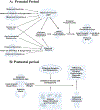Cardiovascular Health Starts in the Womb
- PMID: 39069922
- PMCID: PMC11410535
- DOI: 10.1161/HYPERTENSIONAHA.124.21359
Cardiovascular Health Starts in the Womb
Erratum in
-
Correction to: Cardiovascular Health Starts in the Womb.Hypertension. 2025 Jul;82(7):e140. doi: 10.1161/HYP.0000000000000245. Epub 2025 Jun 18. Hypertension. 2025. PMID: 40532023 No abstract available.
Abstract
Hypertension has largely been viewed as a disorder of adulthood. Historically, blood pressure (BP) was not routinely measured in children because hypertension was considered uncommon in childhood. It was not until the 1970s that it was apparent that in childhood BP levels were normally lower compared with those in adults, were related to age and growth, and that abnormal BP in children needed different definitions. Based on the distribution of BP levels in available child cohorts, the 95th percentile of BP levels became the definition of hypertension in children and adolescents-an epidemiological definition. Subsequent clinical and epidemiological research identified associated risk factors in childhood that linked abnormal BP in youth with hypertension in adulthood. In the 1980s, the Barker hypothesis, based on observations that low birth weight could be linked to cardiovascular disease in adulthood, promoted further research spanning epidemiological, clinical, and basic science on the childhood origins of hypertension. This review focuses on recent findings from both longitudinal maternal-child cohorts and experimental models that examine both maternal and offspring conditions associated with risks of subsequent cardiovascular disease.
Keywords: adolescent; adult; birth weight; blood pressure; hypertension; pre-eclampsia; risk factors.
Conflict of interest statement
None.
Figures

References
-
- National Heart L, and Blood Institute. Report of the Task force on Blood Pressure Control in Children. Pediatrics 1977;59:797–820. - PubMed
-
- Barker DJ, Osmond C, Golding J, Kuh D, Wadsworth ME. Growth in utero, blood pressure in childhood and adult life, and mortality from cardiovascular disease. BMJ 1989;298(6673):564–7. http://www.ncbi.nlm.nih.gov/pubmed/2495113. - PMC - PubMed
-
- WHO-unicf. (https://data.unicef.org/topic/nutrition/low-birthweight/ ). Accessed April 29,2024
-
- WHO (https://www.who.int/news-room/fact-sheets/detail/preterm-birth]). Accessed April 29, 2024
Publication types
MeSH terms
Grants and funding
LinkOut - more resources
Full Text Sources
Medical

